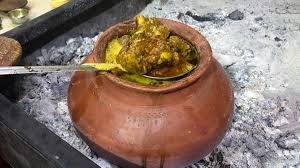Hotel Management Class Notes 40
Mutton Handi is a beloved dish in South Asian cuisine, particularly popular in Indian and Pakistani households. Known for its rich flavors and tender meat, this dish gets its name from the traditional earthen pot, or “handi,” in which it is cooked. The slow-cooking method in a handi allows the flavors to meld beautifully, resulting in a hearty and aromatic curry that is perfect for special occasions and everyday meals alike.

Ingredients and Preparation
The primary ingredients for Mutton Handi include mutton (usually goat meat), yogurt, a variety of spices, and aromatics like onions, garlic, and ginger. The dish often features tomatoes, green chilies, and fresh herbs such as coriander and mint, which enhance its flavor profile.
Preparation begins with marinating the mutton in yogurt and spices. Common spices used in the marinade include turmeric, red chili powder, cumin, and coriander. The yogurt tenderizes the meat and adds a creamy texture to the dish. After marinating for a few hours or overnight, the mutton is ready to be cooked.
The cooking process starts with heating oil or ghee in the handi. Sliced onions are sautéed until golden brown, creating a rich base for the curry. Once the onions are caramelized, the marinated mutton is added to the pot, searing it to lock in juices. Following this, chopped tomatoes, ginger, garlic, and green chilies are incorporated, creating a robust and aromatic mixture.

Cooking Techniques
Mutton Handi is traditionally cooked on low heat, allowing the meat to become tender while absorbing the spices. The handi’s thick walls retain heat effectively, ensuring an even cooking process. As the dish simmers, the flavors deepen, and the meat becomes succulent.
A key feature of Mutton Handi is its layering. Some recipes include layers of fried onions, fresh herbs, and even potatoes, which soak up the flavorful gravy. The dish is often finished with a drizzle of fresh cream or a sprinkle of garam masala, elevating its richness and aroma.
Serving Suggestions
Mutton Handi is typically served hot, often garnished with fresh coriander leaves and slices of green chili. It pairs wonderfully with naan, roti, or steamed rice, allowing diners to enjoy the rich gravy fully. The dish is frequently served at family gatherings, weddings, and festive occasions, making it a centerpiece for communal dining.

Cultural Significance
Mutton Handi holds cultural significance in South Asian cuisine, representing a tradition of communal cooking and sharing. The use of the handi pot not only enhances the flavor but also evokes a sense of nostalgia and connection to heritage. Many families have their unique recipes, passed down through generations, making each version of Mutton Handi special and distinct.
In addition to being a staple in households, Mutton Handi is also a popular offering in restaurants and at special events, further cementing its place in culinary culture. The dish embodies the essence of South Asian cooking, where spices, cooking techniques, and community come together to create an unforgettable dining experience.

Conclusion
In conclusion, Mutton Handi is a rich and flavorful dish that showcases the depth of South Asian culinary traditions. With its tender meat, aromatic spices, and creamy gravy, it offers a satisfying experience for food lovers. Whether enjoyed at a family gathering or a festive celebration, Mutton Handi is more than just a meal; it represents a connection to culture, family, and the joy of sharing food with loved ones.



